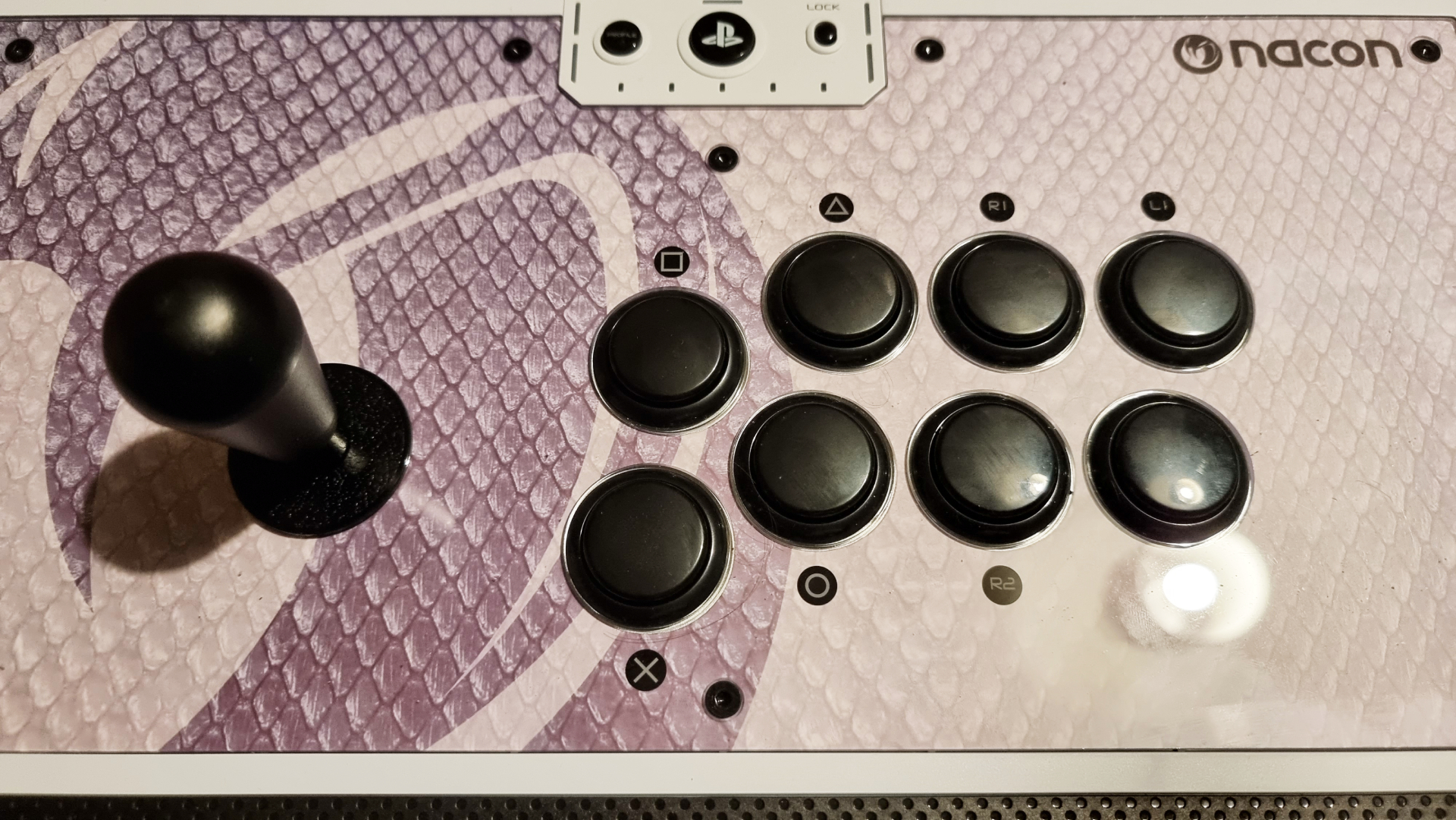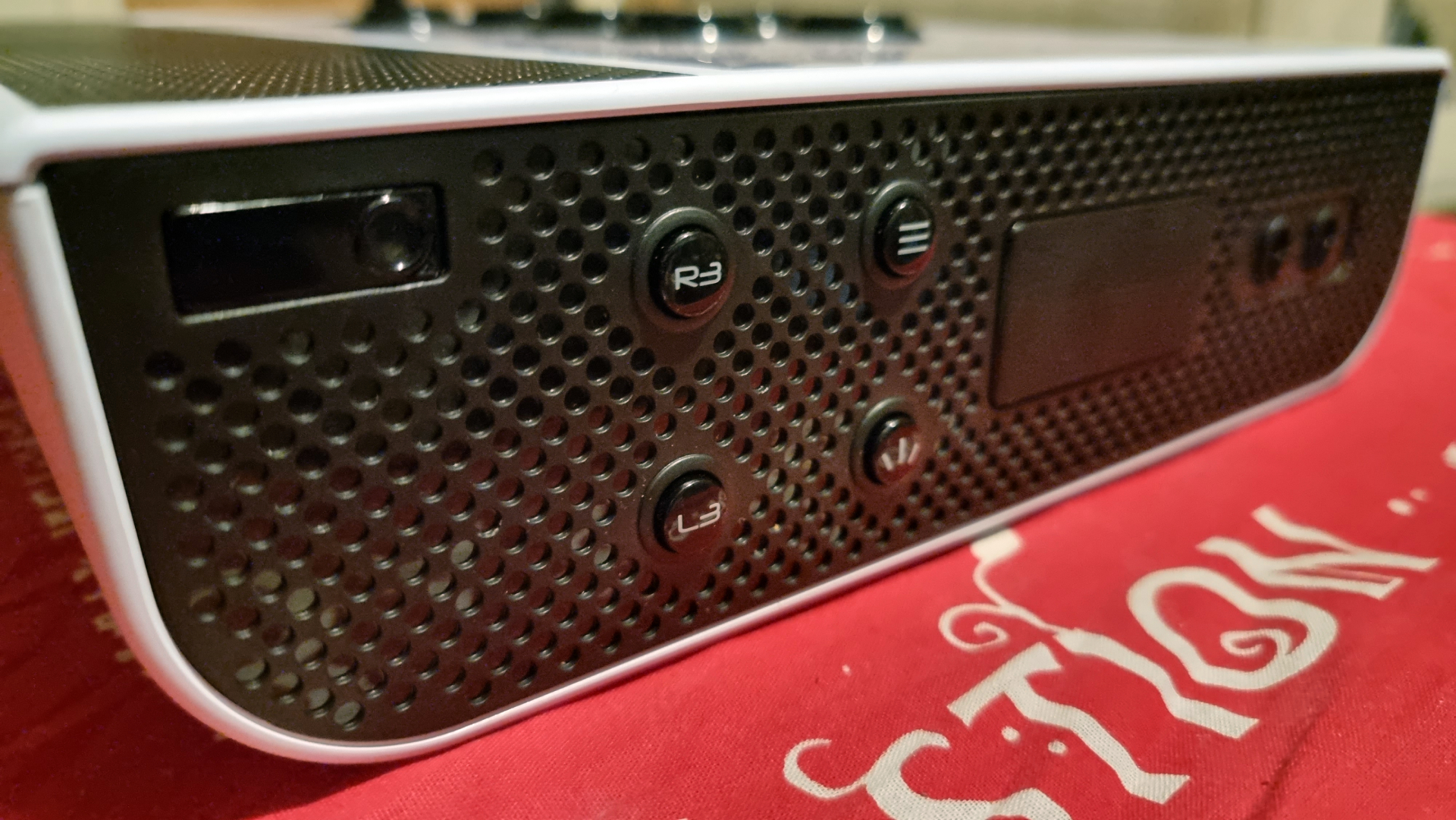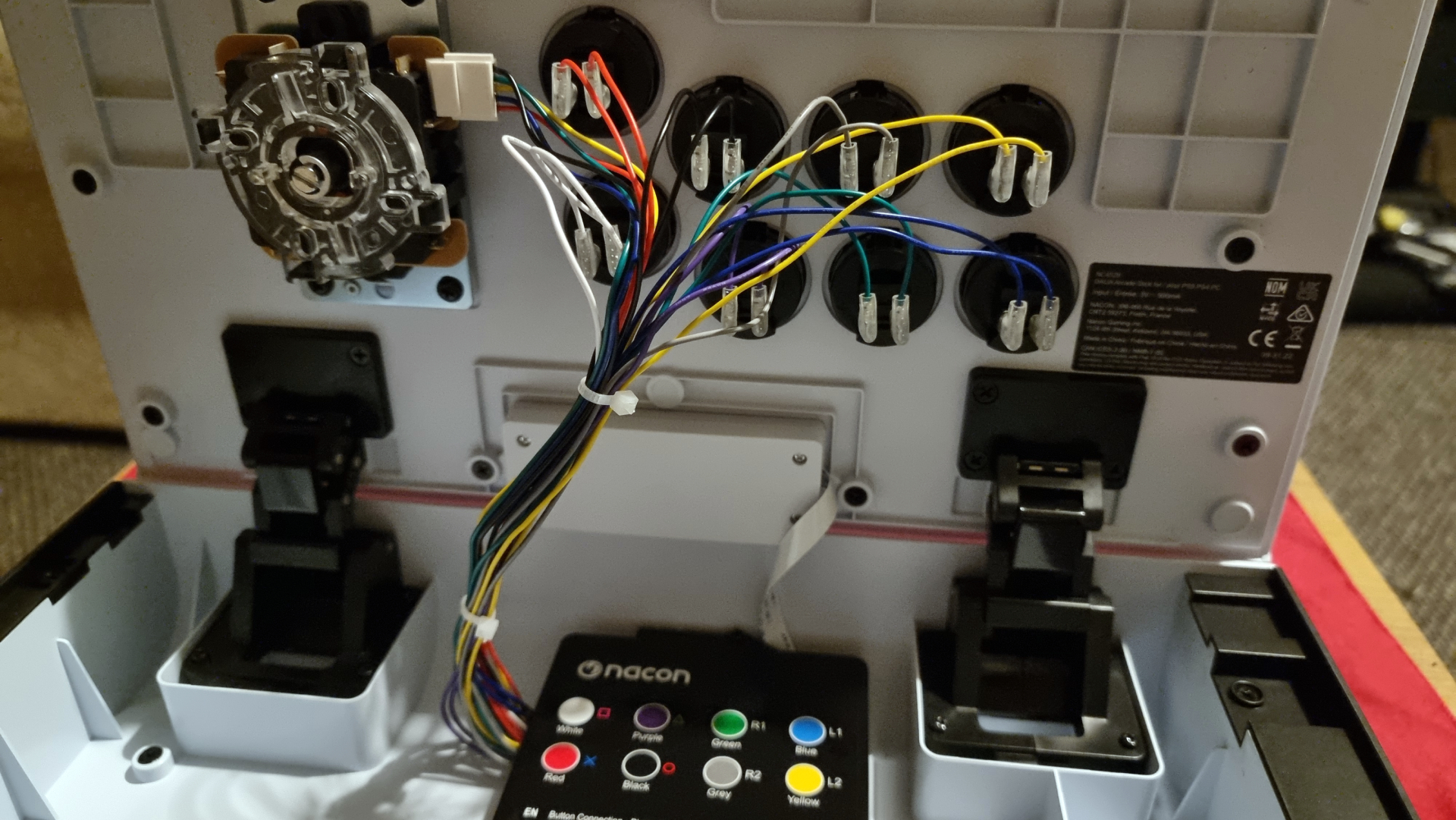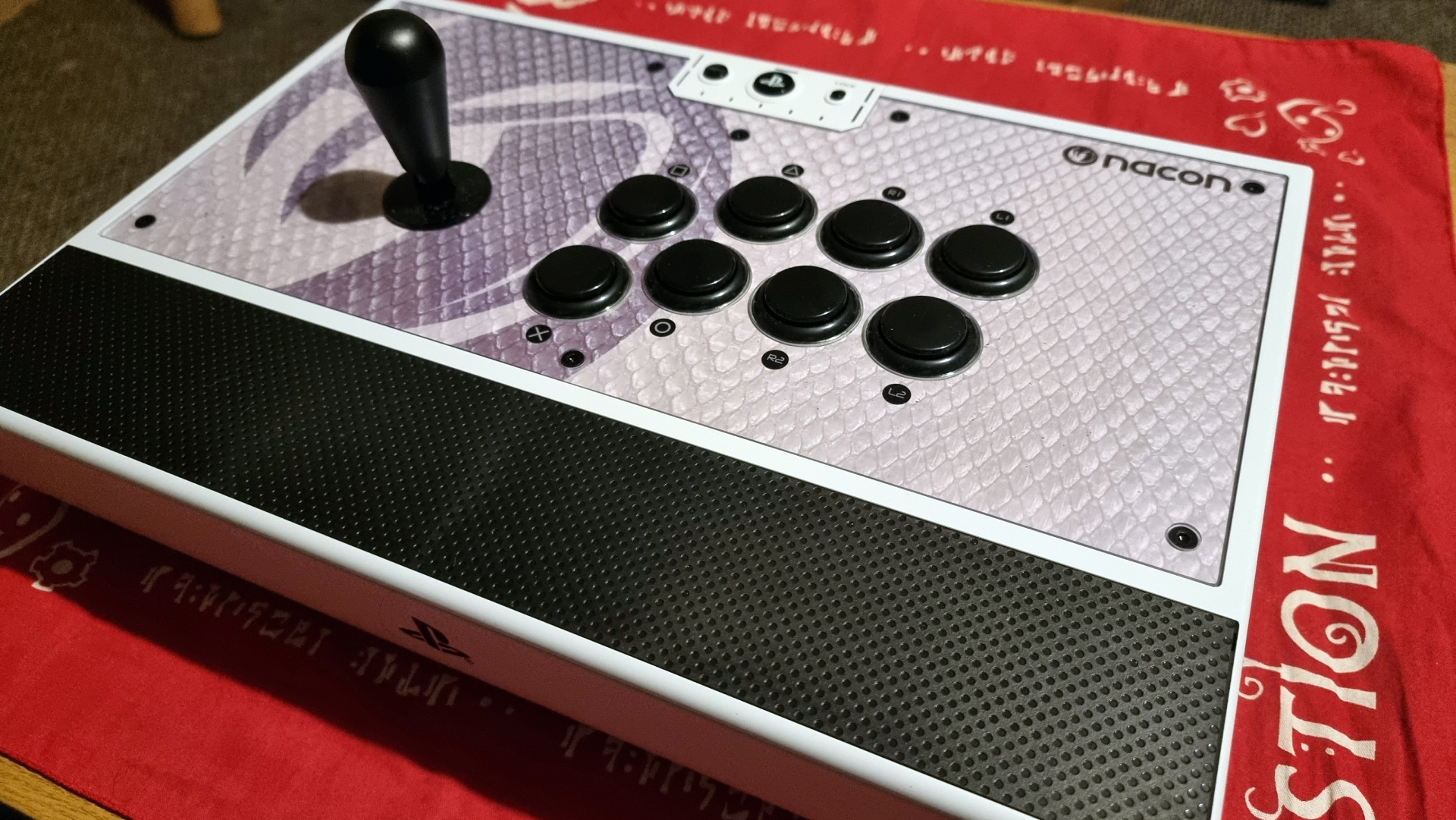Nacon Daija arcade stick review
The Nacon Daija arcade stick caused me to balk at its massive size and weight out of the box, but its quality is immediately apparent. The padded underside allows the stick to rest sturdily on most flat surfaces, while the spacious area around the buttons and joystick gives your hands plenty of room to maneuver.
Once you’ve found a choice spot to place the Daija, developed in partnership with FGC veteran Kayane, you’ll find a weighty and satisfying arcade stick experience. The Sanwa-manufactured joystick and buttons are of a high quality and feel great to use; their short travel time ensures commands are executed quickly and responsively.
Customization is also remarkably simple. Locks on both sides of the stick let you pop the top open when pressed inward. Inside you’ll find a bat top (the ball top is fixed to the stick out of the box) and tools to unscrew and replace the stick’s components. I found swapping parts on the stick to be very straightforward, making the Daija an excellent choice for veterans and beginners alike.
If it’s within your budget, then, the Nacon Daija is easy to recommend. And if you can get used to the initial heft, you’ll find an arcade stick that should serve you well for years, especially with big releases like Street Fighter 6 and Tekken 8 on the horizon.
Price and availability

The Nacon Daija arcade stick can be bought from Nacon’s official store page. It’s listed as €279.90 there, which roughly converts to $292 / £240. As arcade sticks go, the Nacon Daija is certainly on the pricier side, but know that you’re getting an excellent peripheral for your money, thanks to its high-quality build, parts, and pitch-perfect responsiveness.
The Nacon Daija is available in PS5 / PS4 and Xbox Series X|S flavors, so be sure you’re buying the right stick for your console of choice. Thankfully, both sticks also work on PC. So if you primarily play on desktop, the differences largely come down to aesthetics.
Design

If the Nacon Daija is your first stick – or you’re used to playing with smaller devices – you might be alarmed by its massive size and weight. This is to your benefit, however, as the bulky build paired with its padded underside allows it to sit firmly on flat surfaces or in your lap.
Your first port of call will likely be testing out the joystick and face buttons, both of which feel fantastic to use. The eight-face buttons sit in two rows of four and offer little resistance when pressed. This gives the buttons a lovely, springy feel that makes sequential combos and multi-button inputs a breeze to pull off.
The Nacon Daija’s joystick feels equally good to use. It features a square gate reminiscent of the sticks you find on arcade cabinets, and it gives you plenty of freedom when inputting more complex directional commands.
Ancillary buttons – including L3, R3, a PS5-equivalent touchpad, and more – are located on the right side of the device. While it’ll take some muscle memory to use these without needing to look, their placement means they’re not crowding around the joystick and face buttons, making them entirely unintrusive. Toggle switches are also found here; one to change your operational device (PS5, PS4, or PC), and another to map the joystick to the left or right analog stick input.
Rounding out button placement are those found at the top of the stick. Here you’ll find your console’s Home button and another to switch button profiles made through the Nacon companion app. A final switch at the top allows you to lock the Home and Profile buttons to prevent activating them during play. This is an excellent addition if you’re playing in an online or tournament environment, as it completely eliminates the risk of backing out of a match.
Performance

The Nacon Daija arcade stick is primarily designed for fighting games, its button layout allowing you to fully take advantage of the 4-button setups of games like Dragonball FighterZ and The King of Fighters 15, or 6-button games like Street Fighter 5 or those featured in the Capcom Fighting Collection.
No matter which game you choose to play, responsiveness is on point across the board. We tested a wide range of fighting games with the Nacon Daija. Those included contemporary fighters like Guilty Gear Strive and those with 3-dimensional movement like Tekken 7 and Soul Calibur 6.
I also found the Daija to be a great fit for arcade-style games, including beat-em-ups like Streets of Rage 4 and Teenage Mutant Ninja Turtles: Shredders Revenge. Shmups and run n’ guns like Crimzon Clover and Metal Slug 3 were also remarkably fun to play with the stick. This makes it a superb alternative to controllers for most games with an arcade-style button layout.
Overall, the Daija is a versatile stick that complements practically any fighting game out there. And as a result, I got much usage out of its custom button profile support. Button layouts change from game to game, so being able to switch to an ideal layout at the press of a button made hopping between games a breeze.
Should I buy the Nacon Daija arcade stick?

Buy it if...
You want the utmost quality
The Daija excels when it comes to build quality and responsiveness. If you’re after a premium experience, definitely consider the Daija first.
You like customization
Whether you’re swapping out parts on the stick or making your own button layout profiles, customizing the Daija is straightforward and surprisingly fun.
You’re a tournament player
The Daija has forward-thinking options like a Lock switch that makes it ideal for both online and in-person tournament environments.
Don't buy it if...
You’re on a budget
The Daija’s an expensive piece of kit. There are cheaper options out there, though they don’t have the same range of features or premium build quality.
You want something lighter
The Daija isn’t the most portable stick in the world. Smaller, lighter options may benefit you if you like to take your stick on the go.
You prefer controllers
Most modern fighting games are designed with controllers in mind, and you certainly don’t need an arcade stick to enjoy them fully.
0 comments:
Post a Comment